38 PROPERTY FROM A PRIVATE AMERICAN COLLECTION Gilbert & George Spitalfields 1980 16 black and white photographs, in artist's frames 243.8 x 203.2 cm (96 x 80 in.) Signed, titled and dated 'SPITALFIELDS Gilbert and George 1980' lower right. Each framed part individually named, titled and consecutively numbered 'GILBERT + GEORGE SPITALFIELDS No. 1-16/16' on the reverse.
Provenance Anthony d'Offay Gallery, London Private Collection, New York Sotheby's, New York, Contemporary Art, 18 May, 2000, lot 170 Private Collection Christie's, London, Post-War and Contemporary Art Evening Sale, 30 June, 2009, lot 34 Acquired at the above sale by the present owner Exhibited London, Anthony d'Offay Gallery, Gilbert & George: Modern Fears, 1980 Eindhoven, Van Abbemuseum, Gilbert & George, November 1980 , then traveled to Dusseldorf, Kunsthalle (January 1981), Paris, Musée national d'Art moderne, Centre Georges Pompidou (April 1981), London, Whitechapel Art Gallery (July 1981) Bordeaux, CAPC Musée d'Art contemporain, Gilbert & George, The Complete Pictures 1971-1985, May - September 1986 , then traveled to Basel, Kunsthalle (September - November 1986), Brussels, Palais des Beaux-Arts (November 1986 - January 1987), Madrid, Palacio de Velázquez, Parque del Retiro (February - March 1987), Munich, Städtische Galerie im Lenbachhaus (April - June 1987), London, Hayward Gallery (July - September 1987) Literature Gilbert & George, exh. cat., Van Abbemuseum, Eindhoven, 1980, p. 296 (illustrated)Gilbert & George, The Complete Pictures 1971-1985, exh. cat., CAPC Musée d'Art contemporain, Bordeaux, 1986, p. 134 (illustrated) R. Fuchs, Gilbert & George: The Complete Pictures 1971-2005, Volume 1 1971-1988, London, 2007, p. 358 (illustrated) Catalogue Essay Gilbert and George have lived together at 8 Fournier Street, a Georgian house in Spitalfields, since 1968. According to George, ‘nothing happens in the world that doesn’t happen in the East End.’ (Gilbert and George in Anna van Praagh, ‘Gilbert and George: “Margaret Thatcher did a lot for art,”’ Telegraph, 5 July 2009). Taking East London as their microcosm, they explore what they have called the three main ‘life-forces’ of art: The Head, The Soul and The Sex. Spitalfields is from a series of large-scale photographic works titled Modern Fears (1980-1981). The duo had begun to introduce colour into their compositions from the mid-seventies, but here return to a haunting monochrome; attenuated and quiet, the themes of sex, death, and religion that pervade so much of their oeuvre are barely suggested. The artists themselves, most often ‘living sculptures’ in their images, are uncharacteristically absent. The possibilities of humanity and meaning are glimpsed in the silhouetted skyline of houses: who lives there and what they are doing remain tantalising propositions. Organic and expansive, the form of the tree branching through the grid assemblage carries a further hint of vibrant life transcending boundaries. The moon (or is it the sun?) that shines beyond imbues the outline with gentle optimism even as an air of mystery reigns. With their idiosyncratic dress sense and unique mission of living as an art form, Gilbert and George are true eccentrics, and a familiar sight in their neighbourhood. They breakfast at the same café at 6:30 every morning, and walk to the same Kurdish restaurant each evening for dinner. Spitalfields is a historic parish with a rich heritage: first settled in Roman times, the area became famous as the heart of the Huguenot silk industry from the 17th century before drawing a large influx of Jews from Eastern Europe and Russia; in the 1970s it became the heart of the Bengali community. Today it remains a lively cultural hub even as gentrification creeps. In this world, yet somehow not quite of it, Gilbert and George view their environment with the detached eye of the flaneur, immersed but distanced through a keen honesty inflected by irony and humour. The graffiti in their Dirty Words series was sourced from these gritty surroundings; further images in Modern Fears include local tramps and other figures from outside mainstream society, with whom Gilbert and George had good reason to identify as a homosexual couple in the era. The caption in Spitalfields’ lower right panel locks its subject in time and place, giving the work the air of a strange pictu
38 PROPERTY FROM A PRIVATE AMERICAN COLLECTION Gilbert & George Spitalfields 1980 16 black and white photographs, in artist's frames 243.8 x 203.2 cm (96 x 80 in.) Signed, titled and dated 'SPITALFIELDS Gilbert and George 1980' lower right. Each framed part individually named, titled and consecutively numbered 'GILBERT + GEORGE SPITALFIELDS No. 1-16/16' on the reverse.
Provenance Anthony d'Offay Gallery, London Private Collection, New York Sotheby's, New York, Contemporary Art, 18 May, 2000, lot 170 Private Collection Christie's, London, Post-War and Contemporary Art Evening Sale, 30 June, 2009, lot 34 Acquired at the above sale by the present owner Exhibited London, Anthony d'Offay Gallery, Gilbert & George: Modern Fears, 1980 Eindhoven, Van Abbemuseum, Gilbert & George, November 1980 , then traveled to Dusseldorf, Kunsthalle (January 1981), Paris, Musée national d'Art moderne, Centre Georges Pompidou (April 1981), London, Whitechapel Art Gallery (July 1981) Bordeaux, CAPC Musée d'Art contemporain, Gilbert & George, The Complete Pictures 1971-1985, May - September 1986 , then traveled to Basel, Kunsthalle (September - November 1986), Brussels, Palais des Beaux-Arts (November 1986 - January 1987), Madrid, Palacio de Velázquez, Parque del Retiro (February - March 1987), Munich, Städtische Galerie im Lenbachhaus (April - June 1987), London, Hayward Gallery (July - September 1987) Literature Gilbert & George, exh. cat., Van Abbemuseum, Eindhoven, 1980, p. 296 (illustrated)Gilbert & George, The Complete Pictures 1971-1985, exh. cat., CAPC Musée d'Art contemporain, Bordeaux, 1986, p. 134 (illustrated) R. Fuchs, Gilbert & George: The Complete Pictures 1971-2005, Volume 1 1971-1988, London, 2007, p. 358 (illustrated) Catalogue Essay Gilbert and George have lived together at 8 Fournier Street, a Georgian house in Spitalfields, since 1968. According to George, ‘nothing happens in the world that doesn’t happen in the East End.’ (Gilbert and George in Anna van Praagh, ‘Gilbert and George: “Margaret Thatcher did a lot for art,”’ Telegraph, 5 July 2009). Taking East London as their microcosm, they explore what they have called the three main ‘life-forces’ of art: The Head, The Soul and The Sex. Spitalfields is from a series of large-scale photographic works titled Modern Fears (1980-1981). The duo had begun to introduce colour into their compositions from the mid-seventies, but here return to a haunting monochrome; attenuated and quiet, the themes of sex, death, and religion that pervade so much of their oeuvre are barely suggested. The artists themselves, most often ‘living sculptures’ in their images, are uncharacteristically absent. The possibilities of humanity and meaning are glimpsed in the silhouetted skyline of houses: who lives there and what they are doing remain tantalising propositions. Organic and expansive, the form of the tree branching through the grid assemblage carries a further hint of vibrant life transcending boundaries. The moon (or is it the sun?) that shines beyond imbues the outline with gentle optimism even as an air of mystery reigns. With their idiosyncratic dress sense and unique mission of living as an art form, Gilbert and George are true eccentrics, and a familiar sight in their neighbourhood. They breakfast at the same café at 6:30 every morning, and walk to the same Kurdish restaurant each evening for dinner. Spitalfields is a historic parish with a rich heritage: first settled in Roman times, the area became famous as the heart of the Huguenot silk industry from the 17th century before drawing a large influx of Jews from Eastern Europe and Russia; in the 1970s it became the heart of the Bengali community. Today it remains a lively cultural hub even as gentrification creeps. In this world, yet somehow not quite of it, Gilbert and George view their environment with the detached eye of the flaneur, immersed but distanced through a keen honesty inflected by irony and humour. The graffiti in their Dirty Words series was sourced from these gritty surroundings; further images in Modern Fears include local tramps and other figures from outside mainstream society, with whom Gilbert and George had good reason to identify as a homosexual couple in the era. The caption in Spitalfields’ lower right panel locks its subject in time and place, giving the work the air of a strange pictu
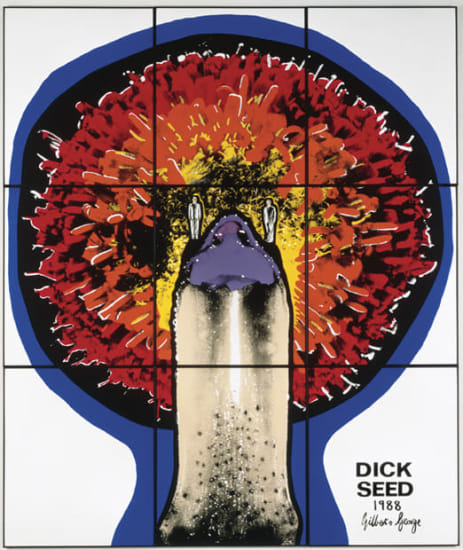
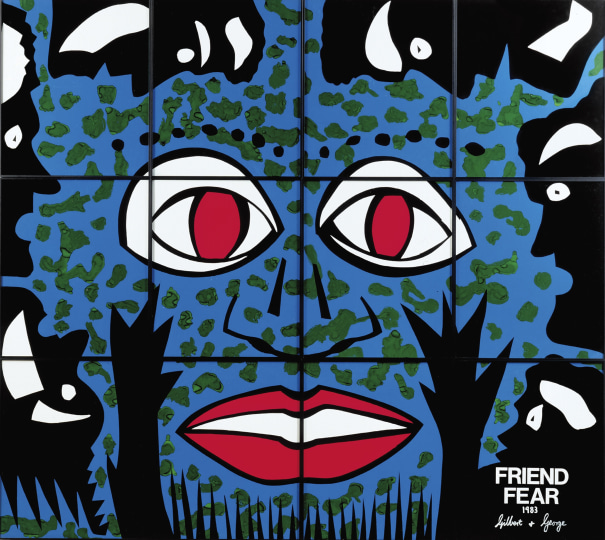

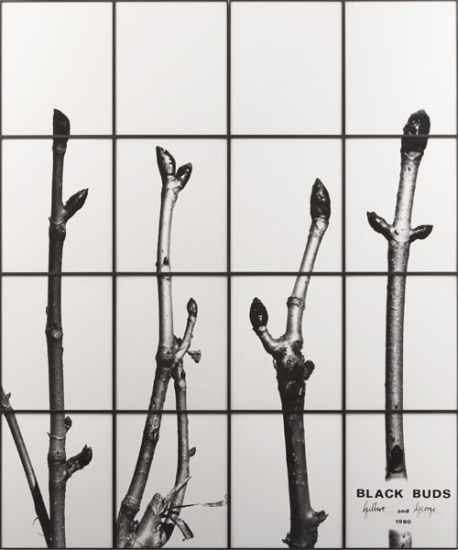
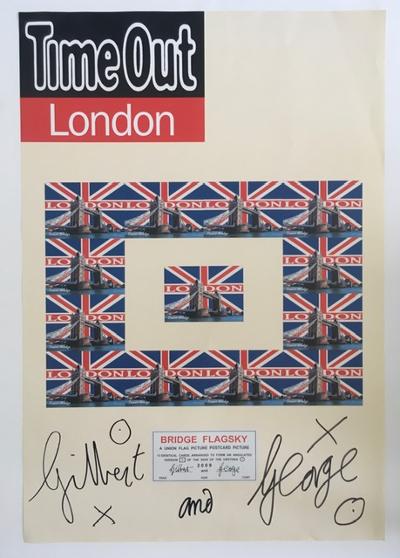


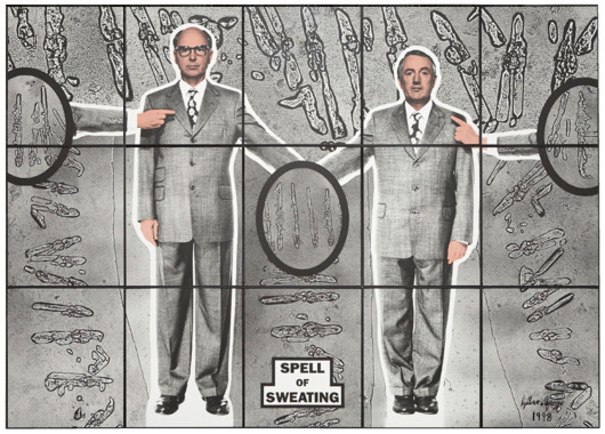
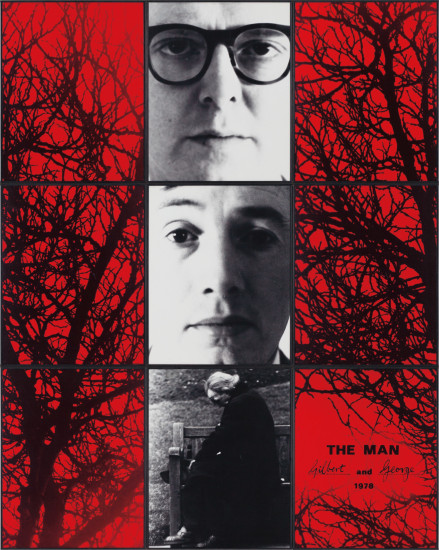
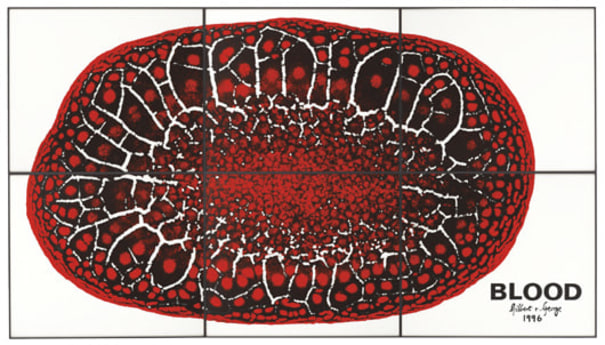

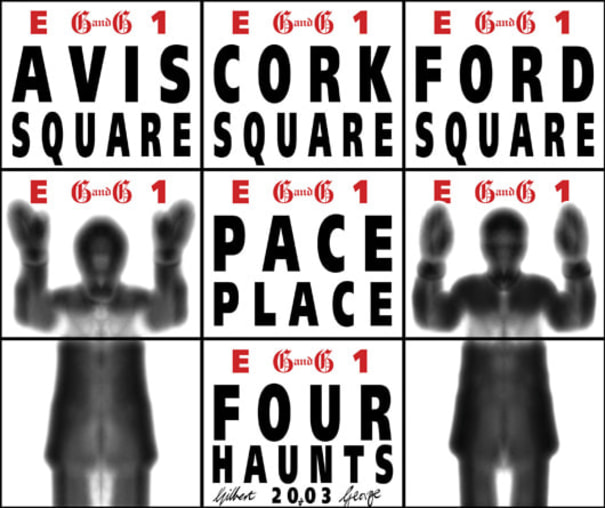
Testen Sie LotSearch und seine Premium-Features 7 Tage - ohne Kosten!
Lassen Sie sich automatisch über neue Objekte in kommenden Auktionen benachrichtigen.
Suchauftrag anlegen